engine INFINITI QX50 2019 Towing Guide
[x] Cancel search | Manufacturer: INFINITI, Model Year: 2019, Model line: QX50, Model: INFINITI QX50 2019Pages: 25, PDF Size: 0.38 MB
Page 2 of 25
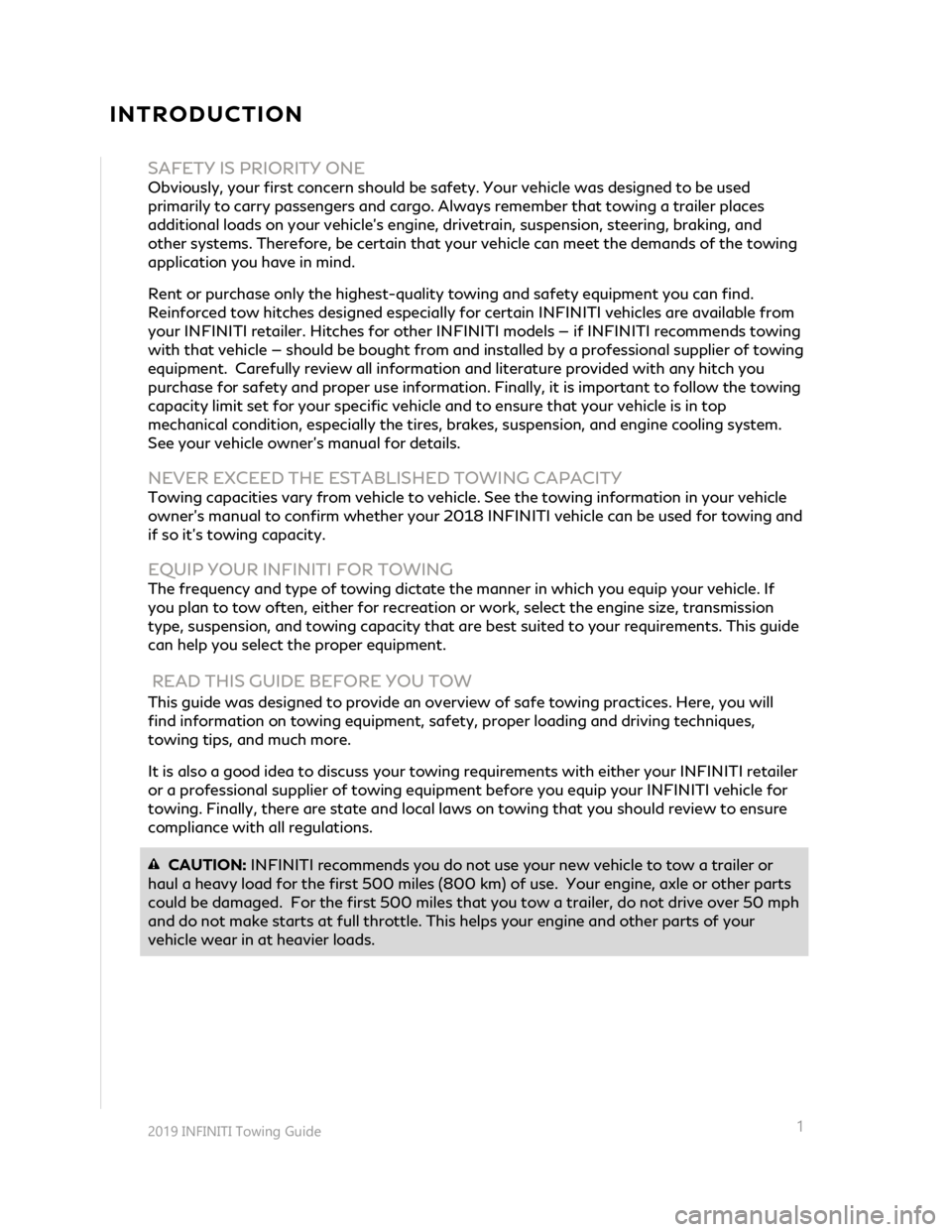
2019 INFINITI Towing Guide
1
SAFETY IS PRIORITY ONE
Obviously, your first concern should be safety. Your vehicle was designed to be used
primarily to carry passengers and cargo. Always remember that towing a trailer places
additional loads on your vehicle’s engine, drivetrain, suspension, steering, braking, and
other systems. Therefore, be certain that your vehicle can meet the demands of the towing
application you have in mind.
Rent or purchase only the highest-quality towing and safety equipment you can find.
Reinforced tow hitches designed especially for certain INFINITI vehicles are available from
your INFINITI retailer. Hitches for other INFINITI models — if INFINITI recommends towing
with that vehicle — should be bought from and installed by a professional supplier of towing
equipment. Carefully review all information and literature provided with any hitch you
purchase for safety and proper use information. Finally, it is important to follow the towing
capacity limit set for your specific vehicle and to ensure that your vehicle is in top
mechanical condition, especially the tires, brakes, suspension, and engine cooling system.
See your vehicle owner’s manual for details.
NEVER EXCEED THE ESTABLISHED TOWING CAPACITY
Towing capacities vary from vehicle to vehicle. See the towing information in your vehicle
owner’s manual to confirm whether your 2018 INFINITI vehicle can be used for towing and
if so it’s towing capacity.
EQUIP YOUR INFINITI FOR TOWING
The frequency and type of towing dictate the manner in which you equip your vehicle. If
you plan to tow often, either for recreation or work, select the engine size, transmission
type, suspension, and towing capacity that are best suited to your requirements. This guide
can help you select the proper equipment.
READ THIS GUIDE BEFORE YOU TOW
This guide was designed to provide an overview of safe towing practices. Here, you will
find information on towing equipment, safety, proper loading and driving techniques,
towing tips, and much more.
It is also a good idea to discuss your towing requirements with either your INFINITI retailer
or a professional supplier of towing equipment before you equip your INFINITI vehicle for
towing. Finally, there are state and local laws on towing that you should review to ensure
compliance with all regulations.
CAUTION: INFINITI recommends you do not use your new vehicle to tow a trailer or
haul a heavy load for the first 500 miles (800 km) of use. Your engine, axle or other parts
could be damaged. For the first 500 miles that you tow a trailer, do not drive over 50 mph
and do not make starts at full throttle. This helps your engine and other parts of your
vehicle wear in at heavier loads.
INTRODUCTION
Page 10 of 25
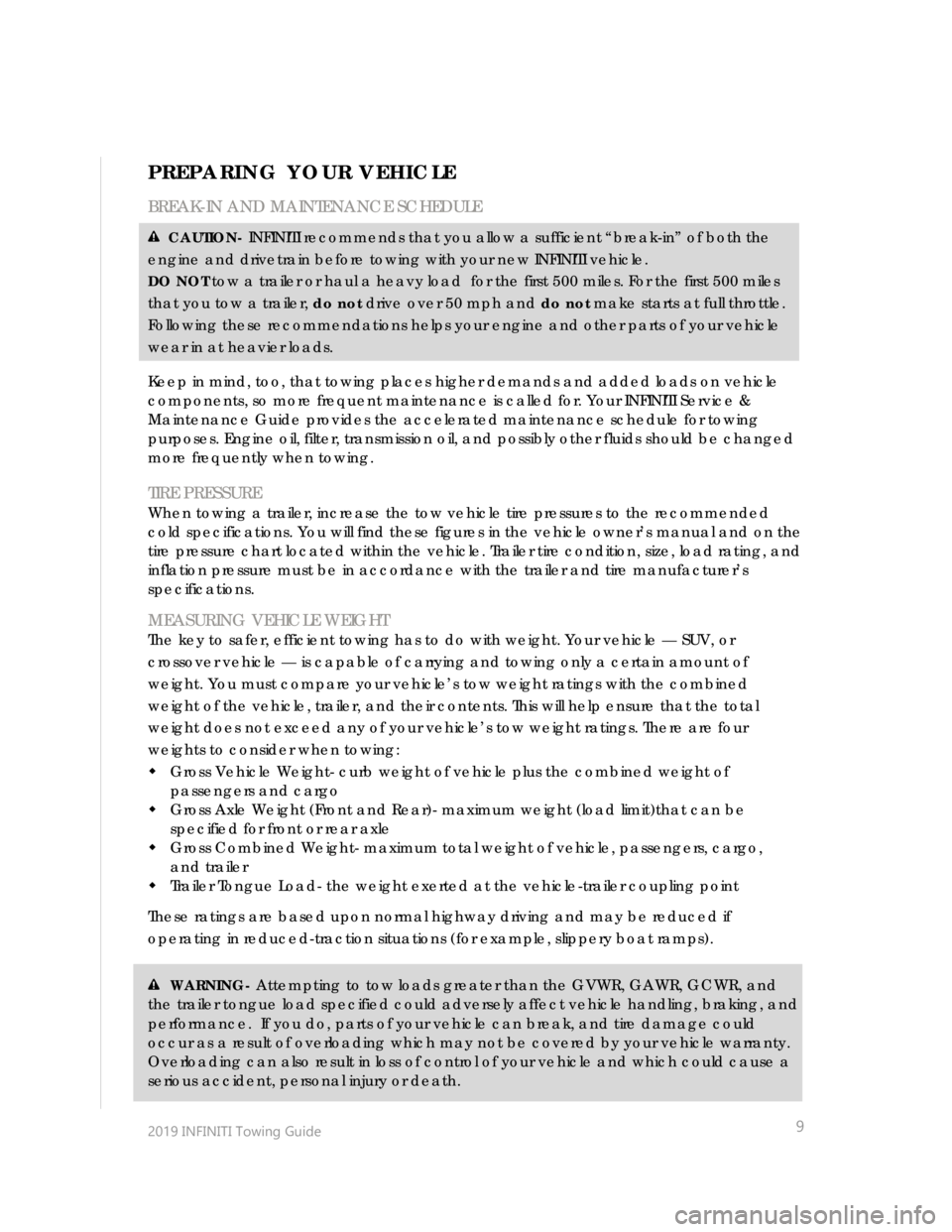
2019 INFINITI Towing Guide
9
PREPARING YOUR VEHICLE
BREAK-IN AND MAINTENANCE SCHEDULE
CAUTION- INFINITI recommends that you allow a sufficient “break-in” of both the
engine and drivetrain before towing with your new INFINITI vehicle.
DO NOT tow a trailer or haul a heavy load for the first 500 miles. For the first 500 miles
that you tow a trailer, do not drive over 50 mph and do not make starts at full throttle.
Following these recommendations helps your engine and other parts of your vehicle
wear in at heavier loads.
Keep in mind, too, that towing places higher demands and added loads on vehicle
components, so more frequent maintenance is called for. Your INFINITI Service &
Maintenance Guide provides the accelerated maintenance schedule for towing
purposes. Engine oil, filter, transmission oil, and possibly other fluids should be changed
more frequently when towing.
TIRE PRESSURE
When towing a trailer, increase the tow vehicle tire pressures to the recommended
cold specifications. You will find these figures in the vehicle owner’s manual and on the
tire pressure chart located within the vehicle. Trailer tire condition, size, load rating, and
inflation pressure must be in accordance with the trailer and tire manufacturer’s
specifications.
MEASURING VEHICLE WEIGHT
The key to safer, efficient towing has to do with weight. Your vehicle — SUV, or
crossover vehicle — is capable of carrying and towing only a certain amount of
weight. You must compare your vehicle’s tow weight ratings with the combined
weight of the vehicle, trailer, and their contents. This will help ensure that the total
weight does not exceed any of your vehicle’s tow weight ratings. There are four
weights to consider when towing:
Gross Vehicle Weight- curb weight of vehicle plus the combined weight of
passengers and cargo
Gross Axle Weight (Front and Rear)- maximum weight (load limit)that can be
specified for front or rear axle
Gross Combined Weight- maximum total weight of vehicle, passengers, cargo,
and trailer
Trailer Tongue Load- the weight exerted at the vehicle-trailer coupling point
These ratings are based upon normal highway driving and may be reduced if
operating in reduced-traction situations (for example, slippery boat ramps).
WARNING- Attempting to tow loads greater than the GVWR, GAWR, GCWR, and
the trailer tongue load specified could adversely affect vehicle handling, braking, and
performance. If you do, parts of your vehicle can break, and tire damage could
occur as a result of overloading which may not be covered by your vehicle warranty.
Overloading can also result in loss of control of your vehicle and which could cause a
serious accident, personal injury or death.
Page 11 of 25
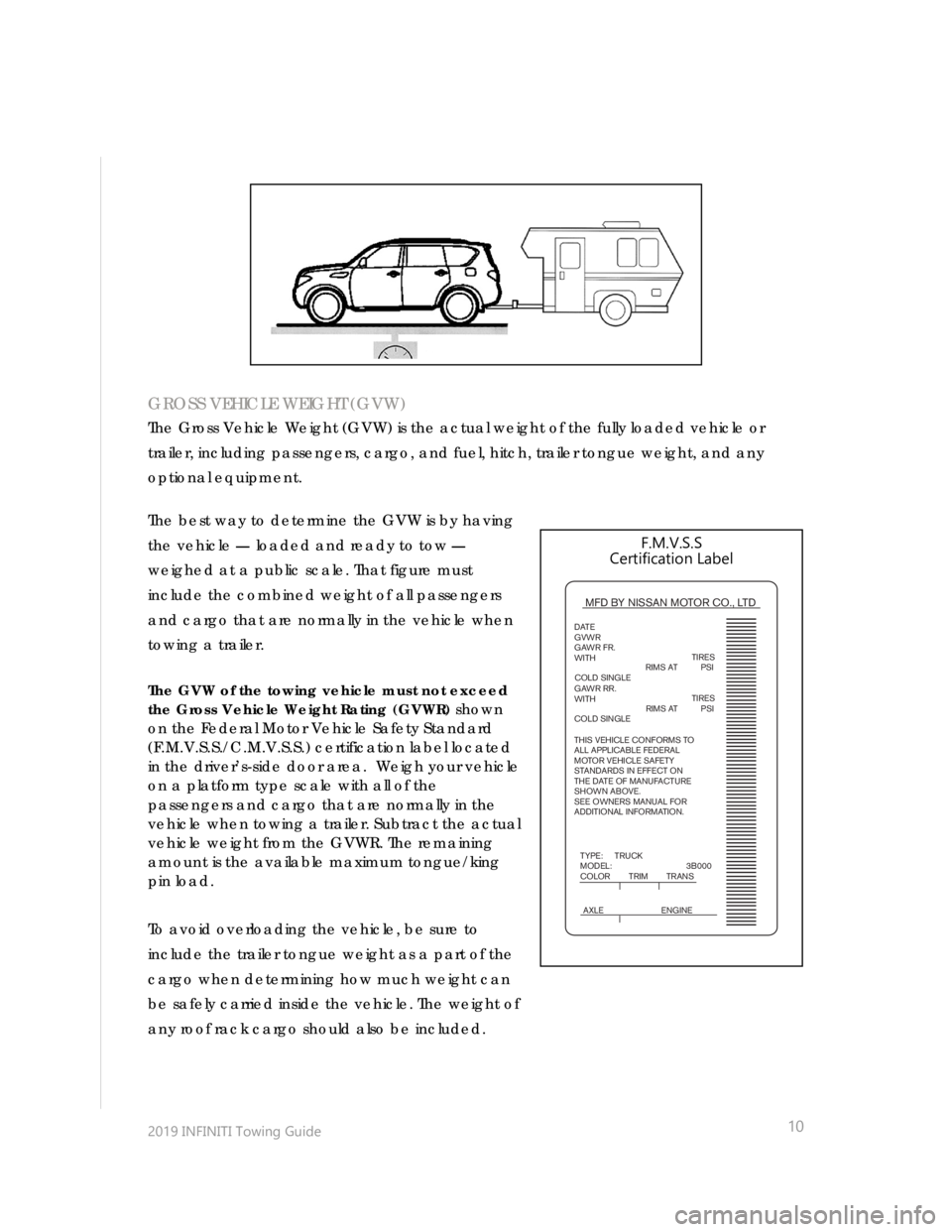
2019 INFINITI Towing Guide
10
GROSS VEHICLE WEIGHT (GVW)
The Gross Vehicle Weight (GVW) is the actual weight of the fully loaded vehicle or
trailer, including passengers, cargo, and fuel, hitch, trailer tongue weight, and any
optional equipment.
The best way to determine the GVW is by having
the vehicle — loaded and ready to tow —
weighed at a public scale. That figure must
include the combined weight of all passengers
and cargo that are normally in the vehicle when
towing a trailer.
The GVW of the towing vehicle must not exceed
the Gross Vehicle Weight Rating (GVWR) shown
on the Federal Motor Vehicle Safety Standard
(F.M.V.S.S./C.M.V.S.S.) certification label located
in the driver’s-side door area. Weigh your vehicle
on a platform type scale with all of the
passengers and cargo that are normally in the
vehicle when towing a trailer. Subtract the actual
vehicle weight from the GVWR. The remaining
amount is the available maximum tongue/king
pin load.
To avoid overloading the vehicle, be sure to
include the trailer tongue weight as a part of the
cargo when determining how much weight can
be safely carried inside the vehicle. The weight of
any roof rack cargo should also be included.
MFD BY NISSAN MOTOR CO., LTD
DATE
GVWR
GAWR FR.
WITH
GAWR RR.
WITH
THIS VEHICLE CONFORMS TO
ALL APPLICABLE FEDERAL
MOTOR VEHICLE SAFETY
STANDARDS IN EFFECT ON
THE DATE OF MANUFACTURE
SHOWN ABOVE.
SEE OWNERS MANUAL FOR
ADDITIONAL INFORMATION.
TIRES
TIRES
TYPE: TRUCK
MODEL: 3B000
COLOR TRIM TRANS
AXLE ENGINE
RIMS AT PSI
COLD SINGLERIMS AT PSI
COLD SINGLE
F.M.V.S.S
Certification Label
Page 14 of 25
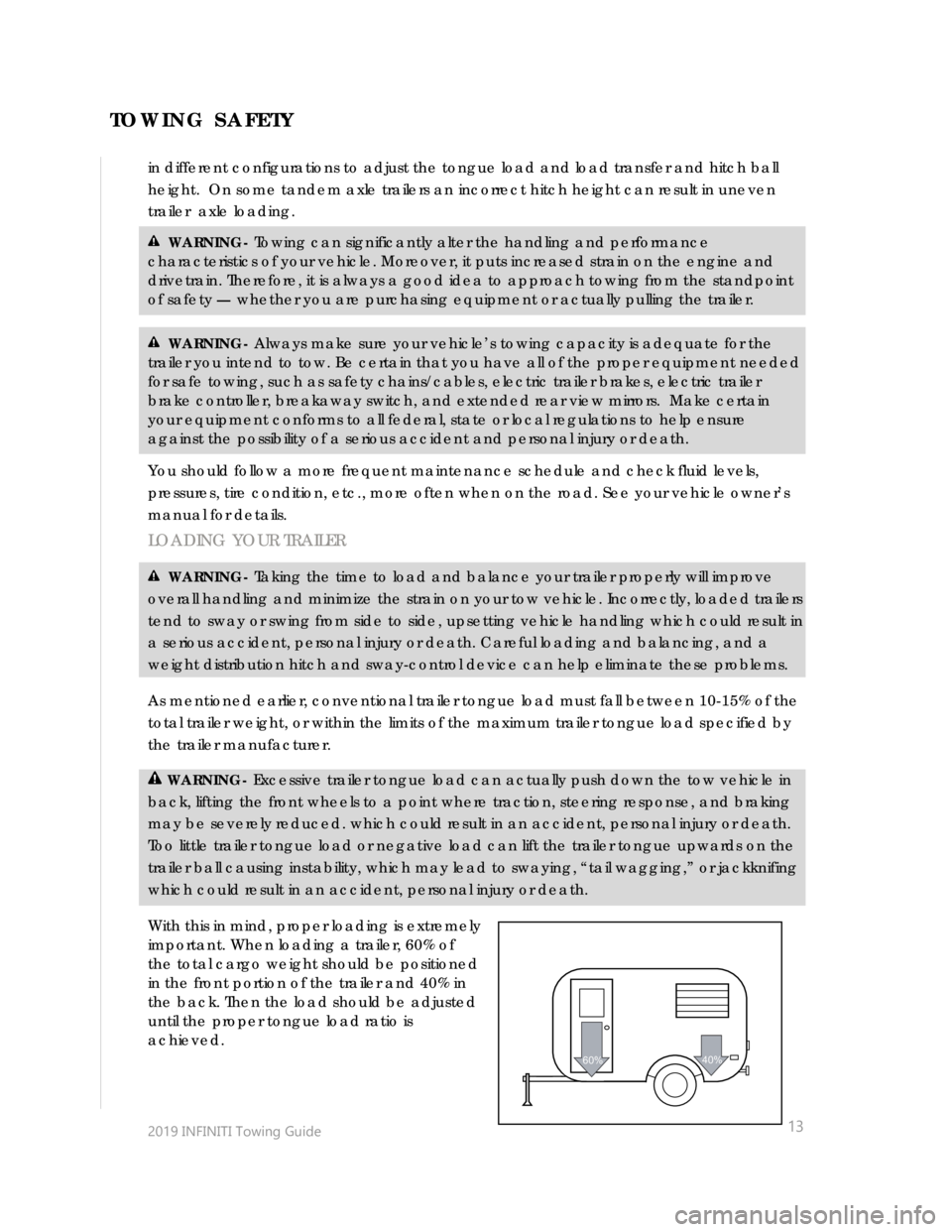
2019 INFINITI Towing Guide
13
in different configurations to adjust the tongue load and load transfer and hitch ball
height. On some tandem axle trailers an incorrect hitch height can result in uneven
trailer axle loading.
WARNING- Towing can significantly alter the handling and performance
characteristics of your vehicle. Moreover, it puts increased strain on the engine and
drivetrain. Therefore, it is always a good idea to approach towing from the standpoint
of safety — whether you are purchasing equipment or actually pulling the trailer.
WARNING- Always make sure your vehicle’s towing capacity is adequate for the
trailer you intend to tow. Be certain that you have all of the proper equipment needed
for safe towing, such as safety chains/cables, electric trailer brakes, electric trailer
brake controller, breakaway switch, and extended rear view mirrors. Make certain
your equipment conforms to all federal, state or local regulations to help ensure
against the possibility of a serious accident and personal injury or death.
You should follow a more frequent maintenance schedule and check fluid levels,
pressures, tire condition, etc., more often when on the road. See your vehicle owner’s
manual for details.
LOADING YOUR TRAILER
WARNING- Taking the time to load and balance your trailer properly will improve
overall handling and minimize the strain on your tow vehicle. Incorrectly, loaded trailers
tend to sway or swing from side to side, upsetting vehicle handling which could result in
a serious accident, personal injury or death. Careful loading and balancing, and a
weight distribution hitch and sway-control device can help eliminate these problems.
As mentioned earlier, conventional trailer tongue load must fall between 10-15% of the
total trailer weight, or within the limits of the maximum trailer tongue load specified by
the trailer manufacturer.
WARNING- Excessive trailer tongue load can actually push down the tow vehicle in
back, lifting the front wheels to a point where traction, steering response, and braking
may be severely reduced. which could result in an accident, personal injury or death.
Too little trailer tongue load or negative load can lift the trailer tongue upwards on the
trailer ball causing instability, which may lead to swaying, “tail wagging,” or jackknifing
which could result in an accident, personal injury or death.
With this in mind, proper loading is extremely
important. When loading a trailer, 60% of
the total cargo weight should be positioned
in the front portion of the trailer and 40% in
the back. Then the load should be adjusted
until the proper tongue load ratio is
achieved.
60%40%
TOWING SAFETY
Page 16 of 25
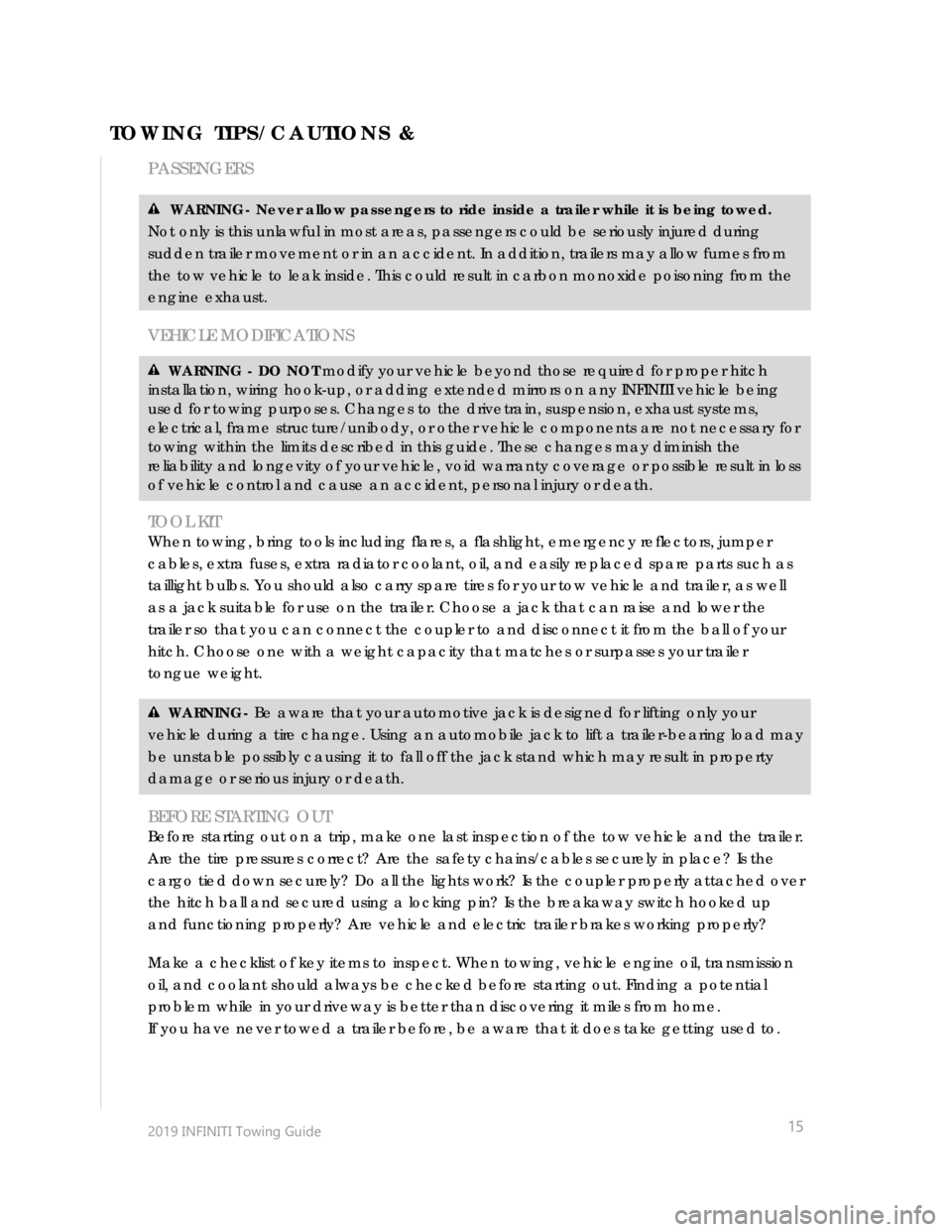
2019 INFINITI Towing Guide
15
PASSENGERS
WARNING- Never allow passengers to ride inside a trailer while it is being towed.
Not only is this unlawful in most areas, passengers could be seriously injured during
sudden trailer movement or in an accident. In addition, trailers may allow fumes from
the tow vehicle to leak inside. This could result in carbon monoxide poisoning from the
engine exhaust.
VEHICLE MODIFICATIONS
WARNING - DO NOT modify your vehicle beyond those required for proper hitch
installation, wiring hook-up, or adding extended mirrors on any INFINITI vehicle being
used for towing purposes. Changes to the drivetrain, suspension, exhaust systems,
electrical, frame structure/unibody, or other vehicle components are not necessary for
towing within the limits described in this guide. These changes may diminish the
reliability and longevity of your vehicle, void warranty coverage or possible result in loss
of vehicle control and cause an accident, personal injury or death.
TOOL KIT
When towing, bring tools including flares, a flashlight, emergency reflectors, jumper
cables, extra fuses, extra radiator coolant, oil, and easily replaced spare parts such as
taillight bulbs. You should also carry spare tires for your tow vehicle and trailer, as well
as a jack suitable for use on the trailer. Choose a jack that can raise and lower the
trailer so that you can connect the coupler to and disconnect it from the ball of your
hitch. Choose one with a weight capacity that matches or surpasses your trailer
tongue weight.
WARNING- Be aware that your automotive jack is designed for lifting only your
vehicle during a tire change. Using an automobile jack to lift a trailer-bearing load may
be unstable possibly causing it to fall off the jack stand which may result in property
damage or serious injury or death.
BEFORE STARTING OUT
Before starting out on a trip, make one last inspection of the tow vehicle and the trailer.
Are the tire pressures correct? Are the safety chains/cables securely in place? Is the
cargo tied down securely? Do all the lights work? Is the coupler properly attached over
the hitch ball and secured using a locking pin? Is the breakaway switch hooked up
and functioning properly? Are vehicle and electric trailer brakes working properly?
Make a checklist of key items to inspect. When towing, vehicle engine oil, transmission
oil, and coolant should always be checked before starting out. Finding a potential
problem while in your driveway is better than discovering it miles from home.
If you have never towed a trailer before, be aware that it does take getting used to.
TOWING TIPS/CAUTIONS &
Page 18 of 25
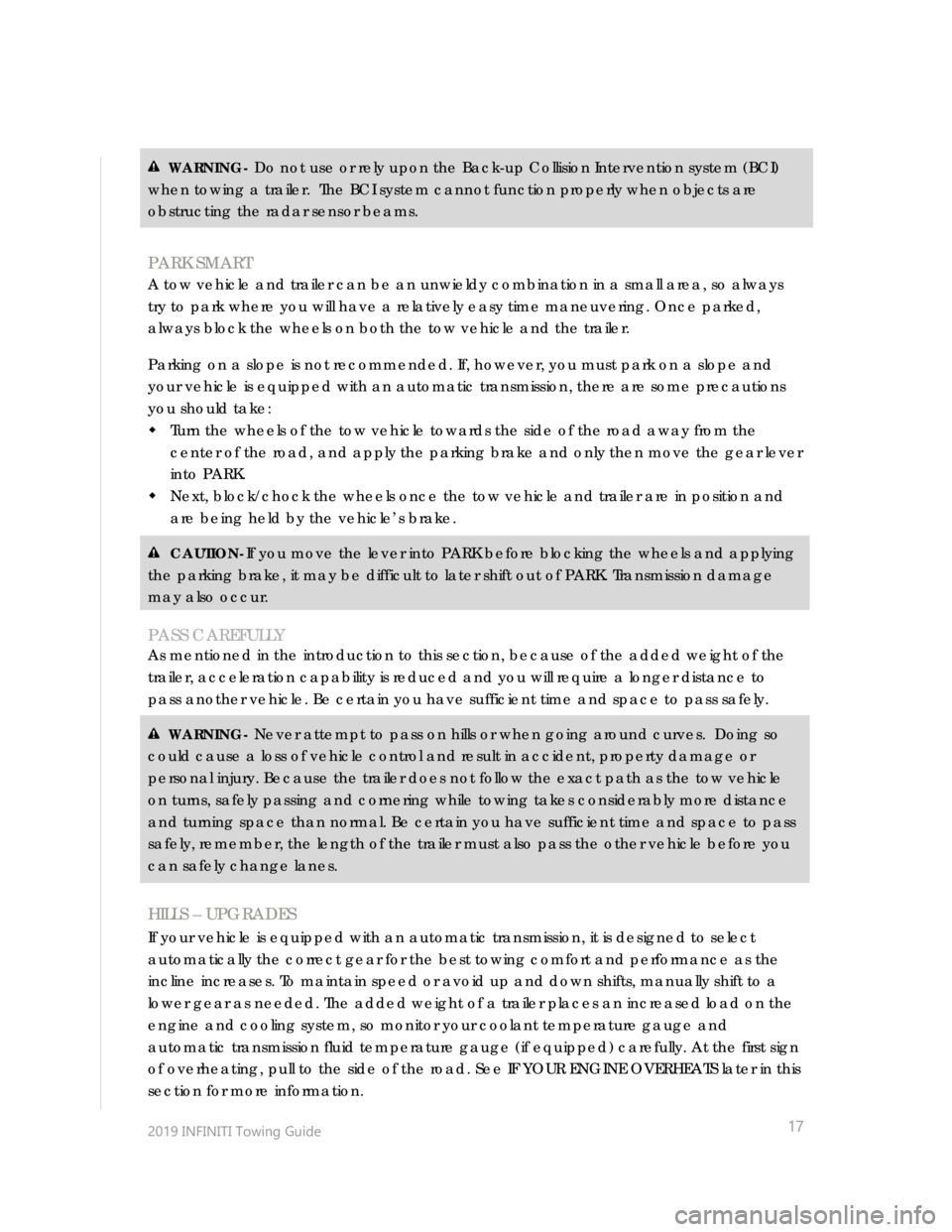
2019 INFINITI Towing Guide
17
WARNING- Do not use or rely upon the Back-up Collision Intervention system (BCI)
when towing a trailer. The BCI system cannot function properly when objects are
obstructing the radar sensor beams.
PARK SMART
A tow vehicle and trailer can be an unwieldy combination in a small area, so always
try to park where you will have a relatively easy time maneuvering. Once parked,
always block the wheels on both the tow vehicle and the trailer.
Parking on a slope is not recommended. If, however, you must park on a slope and
your vehicle is equipped with an automatic transmission, there are some precautions
you should take:
Turn the wheels of the tow vehicle towards the side of the road away from the
center of the road, and apply the parking brake and only then move the gear lever
into PARK.
Next, block/chock the wheels once the tow vehicle and trailer are in position and
are being held by the vehicle’s brake.
CAUTION-If you move the lever into PARK before blocking the wheels and applying
the parking brake, it may be difficult to later shift out of PARK. Transmission damage
may also occur.
PASS CAREFULLY
As mentioned in the introduction to this section, because of the added weight of the
trailer, acceleration capability is reduced and you will require a longer distance to
pass another vehicle. Be certain you have sufficient time and space to pass safely.
WARNING- Never attempt to pass on hills or when going around curves. Doing so
could cause a loss of vehicle control and result in accident, property damage or
personal injury. Because the trailer does not follow the exact path as the tow vehicle
on turns, safely passing and cornering while towing takes considerably more distance
and turning space than normal. Be certain you have sufficient time and space to pass
safely, remember, the length of the trailer must also pass the other vehicle before you
can safely change lanes.
HILLS – UPGRADES
If your vehicle is equipped with an automatic transmission, it is designed to select
automatically the correct gear for the best towing comfort and performance as the
incline increases. To maintain speed or avoid up and down shifts, manually shift to a
lower gear as needed. The added weight of a trailer places an increased load on the
engine and cooling system, so monitor your coolant temperature gauge and
automatic transmission fluid temperature gauge (if equipped) carefully. At the first sign
of overheating, pull to the side of the road. See IF YOUR ENGINE OVERHEATS later in this
section for more information.
Page 19 of 25
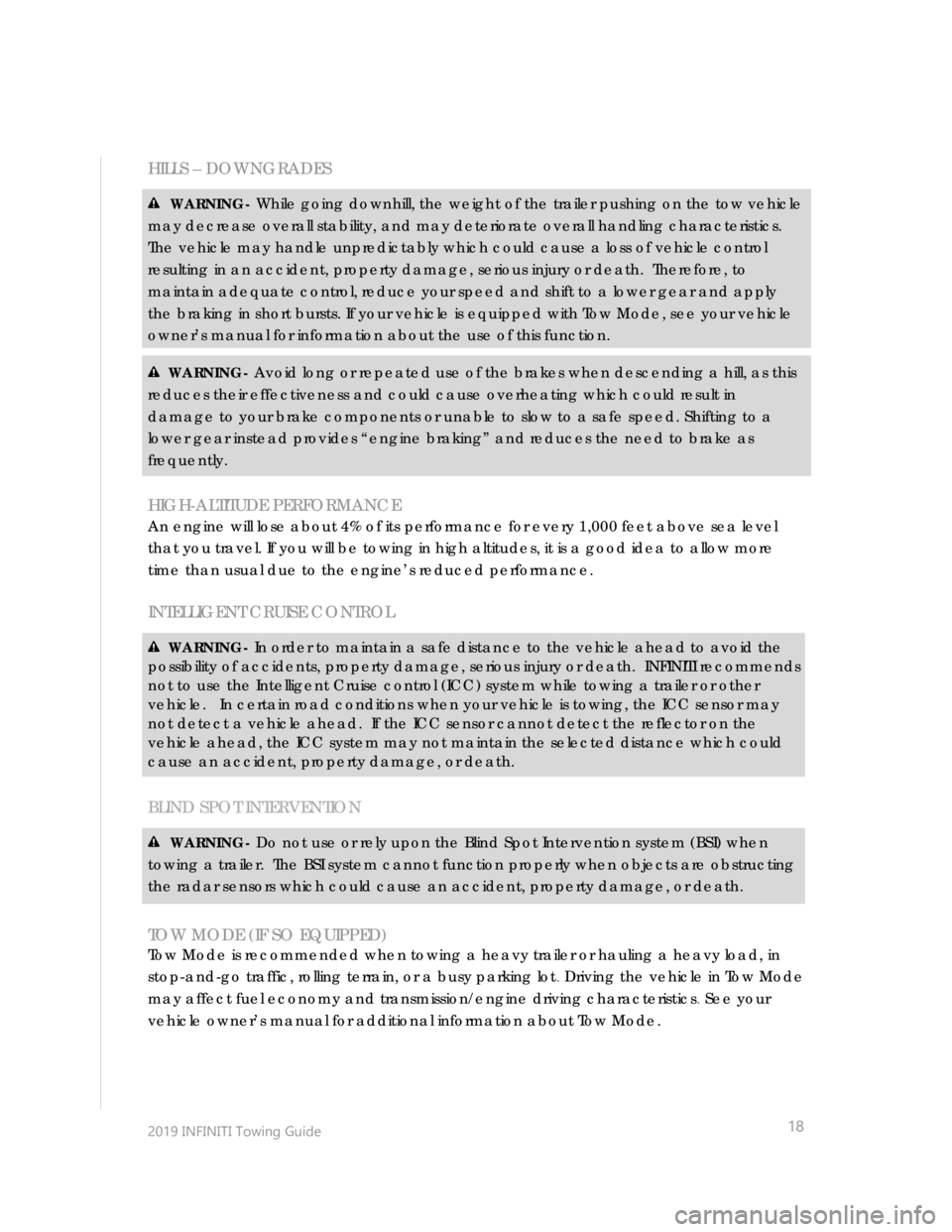
2019 INFINITI Towing Guide
18
HILLS – DOWNGRADES
WARNING- While going downhill, the weight of the trailer pushing on the tow vehicle
may decrease overall stability, and may deteriorate overall handling characteristics.
The vehicle may handle unpredictably which could cause a loss of vehicle control
resulting in an accident, property damage, serious injury or death. Therefore, to
maintain adequate control, reduce your speed and shift to a lower gear and apply
the braking in short bursts. If your vehicle is equipped with Tow Mode, see your vehicle
owner’s manual for information about the use of this function.
WARNING- Avoid long or repeated use of the brakes when descending a hill, as this
reduces their effectiveness and could cause overheating which could result in
damage to your brake components or unable to slow to a safe speed. Shifting to a
lower gear instead provides “engine braking” and reduces the need to brake as
frequently.
HIGH-ALTITUDE PERFORMANCE
An engine will lose about 4% of its performance for every 1,000 feet above sea level
that you travel. If you will be towing in high altitudes, it is a good idea to allow more
time than usual due to the engine’s reduced performance.
INTELLIGENT CRUISE CONTROL
WARNING- In order to maintain a safe distance to the vehicle ahead to avoid the
possibility of accidents, property damage, serious injury or death. INFINITI recommends
not to use the Intelligent Cruise control (ICC) system while towing a trailer or other
vehicle. In certain road conditions when your vehicle is towing, the ICC sensor may
not detect a vehicle ahead. If the ICC sensor cannot detect the reflector on the
vehicle ahead, the ICC system may not maintain the selected distance which could
cause an accident, property damage, or death.
BLIND SPOT INTERVENTION
WARNING- Do not use or rely upon the Blind Spot Intervention system (BSI) when
towing a trailer. The BSI system cannot function properly when objects are obstructing
the radar sensors which could cause an accident, property damage, or death.
TOW MODE (IF SO EQUIPPED)
Tow Mode is recommended when towing a heavy trailer or hauling a heavy load, in
stop-and-go traffic, rolling terrain, or a busy parking lot. Driving the vehicle in Tow Mode
may affect fuel economy and transmission/engine driving characteristics. See your
vehicle owner’s manual for additional information about Tow Mode.
Page 20 of 25
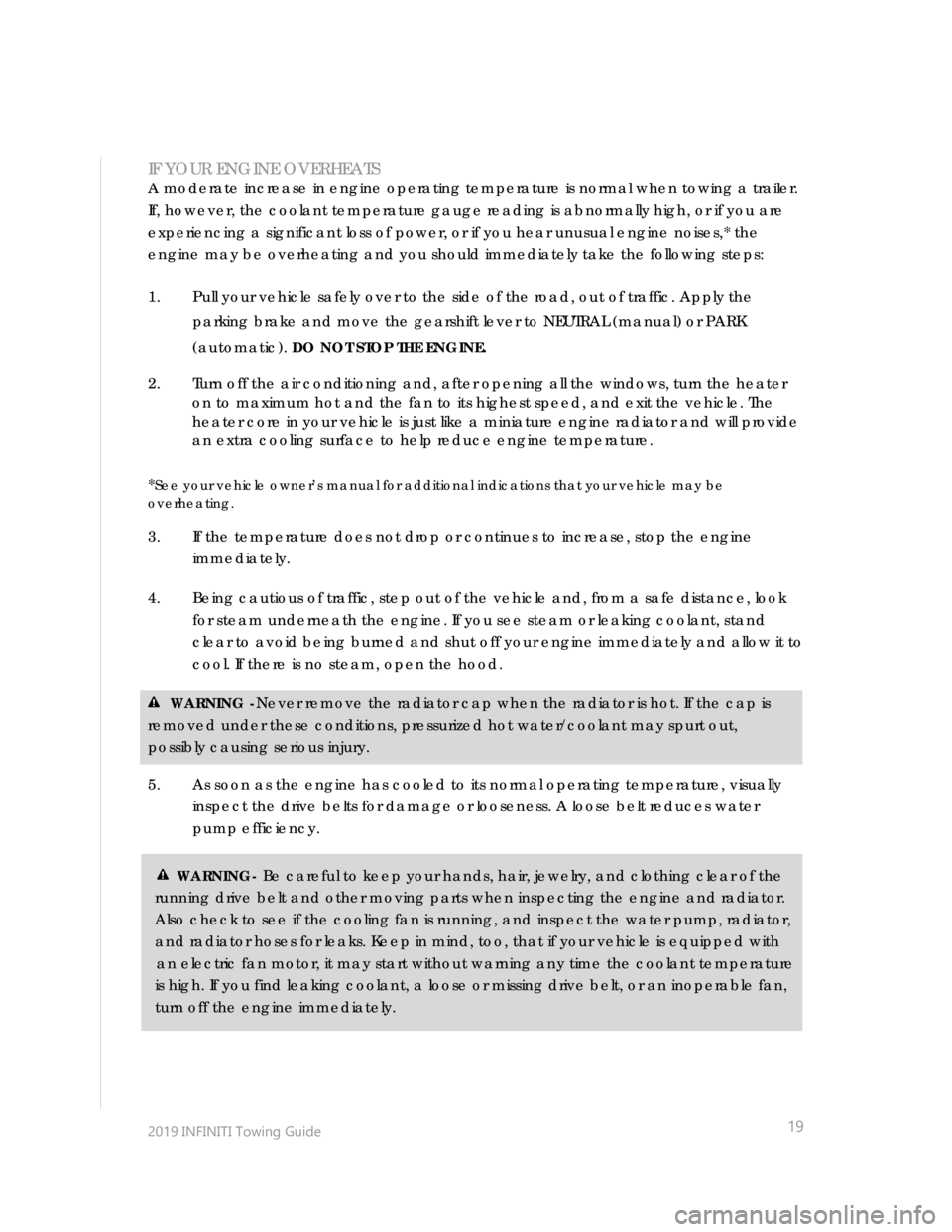
2019 INFINITI Towing Guide
19
IF YOUR ENGINE OVERHEATS
A moderate increase in engine operating temperature is normal when towing a trailer.
If, however, the coolant temperature gauge reading is abnormally high, or if you are
experiencing a significant loss of power, or if you hear unusual engine noises,* the
engine may be overheating and you should immediately take the following steps:
1. Pull your vehicle safely over to the side of the road, out of traffic. Apply the
parking brake and move the gearshift lever to NEUTRAL (manual) or PARK
(automatic). DO NOT STOP THE ENGINE.
2. Turn off the air conditioning and, after opening all the windows, turn the heater
on to maximum hot and the fan to its highest speed, and exit the vehicle. The
heater core in your vehicle is just like a miniature engine radiator and will provide
an extra cooling surface to help reduce engine temperature.
*See your vehicle owner’s manual for additional indications that your vehicle may be
overheating.
3. If the temperature does not drop or continues to increase, stop the engine
immediately.
4. Being cautious of traffic, step out of the vehicle and, from a safe distance, look
for steam underneath the engine. If you see steam or leaking coolant, stand
clear to avoid being burned and shut off your engine immediately and allow it to
cool. If there is no steam, open the hood.
WARNING -Never remove the radiator cap when the radiator is hot. If the cap is
removed under these conditions, pressurized hot water/coolant may spurt out,
possibly causing serious injury.
5. As soon as the engine has cooled to its normal operating temperature, visually
inspect the drive belts for damage or looseness. A loose belt reduces water
pump efficiency.
WARNING- Be careful to keep your hands, hair, jewelry, and clothing clear of the
running drive belt and other moving parts when inspecting the engine and radiator.
Also check to see if the cooling fan is running, and inspect the water pump, radiator,
and radiator hoses for leaks. Keep in mind, too, that if your vehicle is equipped with
an electric fan motor, it may start without warning any time the coolant temperature
is high. If you find leaking coolant, a loose or missing drive belt, or an inoperable fan,
turn off the engine immediately.
Page 21 of 25
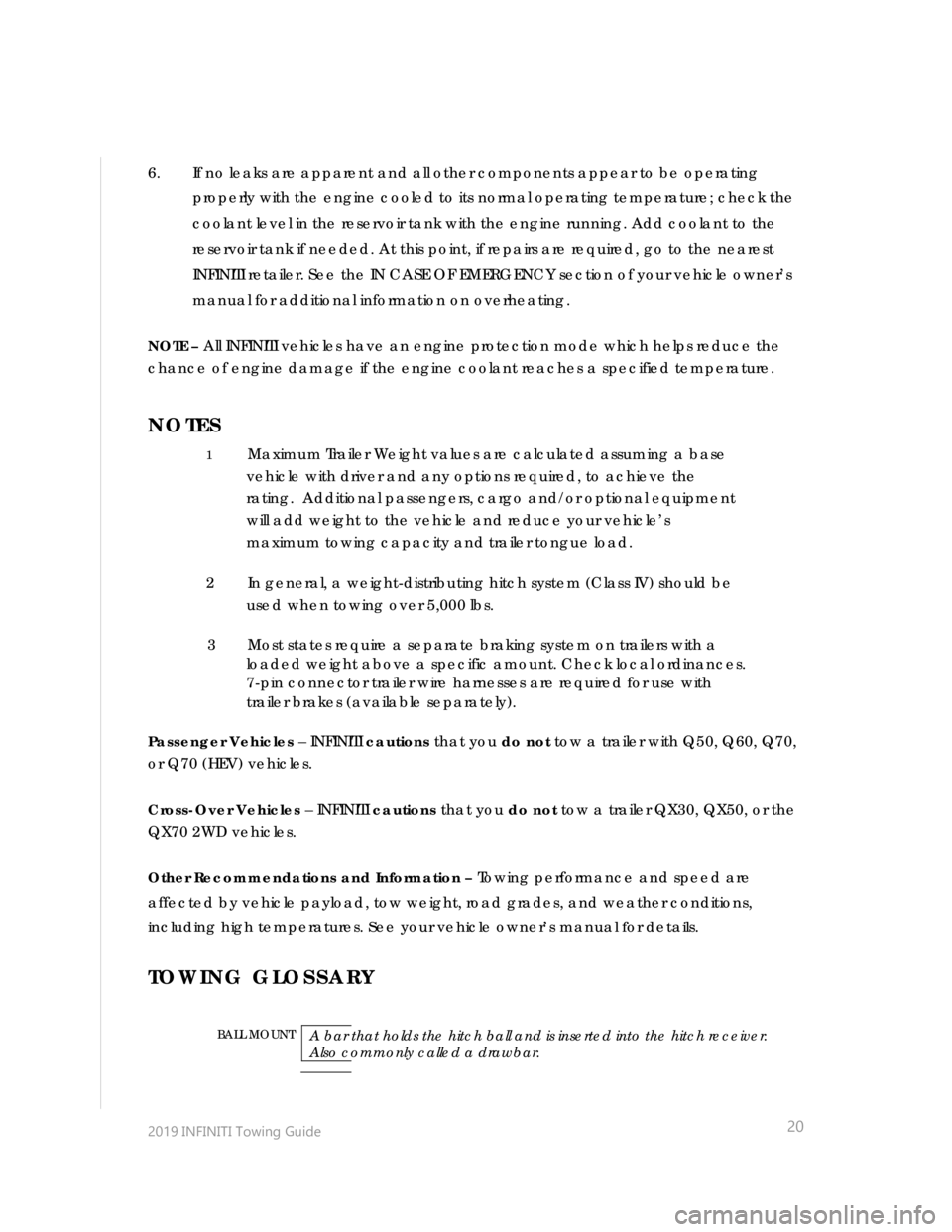
2019 INFINITI Towing Guide
20 6. If no leaks are apparent and all other components appear to be operating
properly with the engine cooled to its normal operating temperature; check the
coolant level in the reservoir tank with the engine running. Add coolant to the
reservoir tank if needed. At this point, if repairs are required, go to the nearest
INFINITI retailer. See the IN CASE OF EMERGENCY section of your vehicle owner’s
manual for additional information on overheating.
NOTE – All INFINITI vehicles have an engine protection mode which helps reduce the
chance of engine damage if the engine coolant reaches a specified temperature.
NOTES
Passenger Vehicles – INFINITI cautions that you do not tow a trailer with Q50, Q60, Q70,
or Q70 (HEV) vehicles.
Cross-Over Vehicles – INFINITI cautions that you do not tow a trailer QX30, QX50, or the
QX70 2WD vehicles.
Other Recommendations and Information – Towing performance and speed are
affected by vehicle payload, tow weight, road grades, and weather conditions,
including high temperatures. See your vehicle owner’s manual for details.
TOWING GLOSSARY
BALL MOUNT A bar that holds the hitch ball and is inserted into the hitch receiver.
Also commonly called a drawbar.
1 Maximum Trailer Weight values are calculated assuming a base
vehicle with driver and any options required, to achieve the
rating. Additional passengers, cargo and/or optional equipment
will add weight to the vehicle and reduce your vehicle’s
maximum towing capacity and trailer tongue load.
2 In general, a weight-distributing hitch system (Class IV) should be
used when towing over 5,000 lbs.
3 Most states require a separate braking system on trailers with a
loaded weight above a specific amount. Check local ordinances.
7-pin connector trailer wire harnesses are required for use with
trailer brakes (available separately).